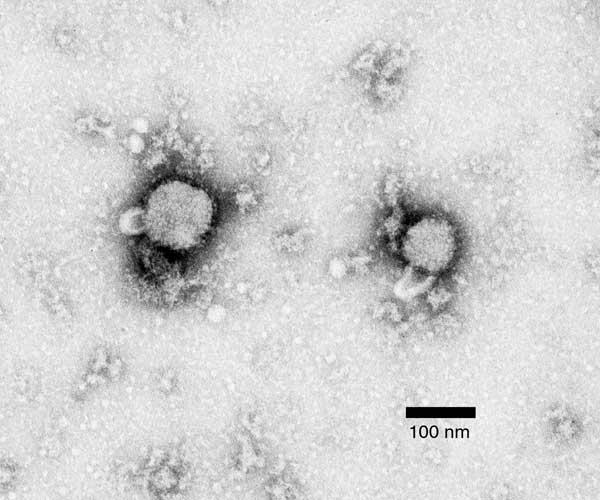Lymphocytic choriomeningitis
 From Wikidoc - Reading time: 3 min
From Wikidoc - Reading time: 3 min
| Lymphocytic Choriomeningitis Virus | ||||||||
|---|---|---|---|---|---|---|---|---|
 Negative stain electron micrograph of an arenavirus from a mouse that tested positive for LCM
| ||||||||
| Virus classification | ||||||||
|
Template:DiseaseDisorder infobox
Overview[edit | edit source]
Lymphocytic choriomeningitis (LCM), is a rodent-borne viral infectious disease that presents as aseptic meningitis, encephalitis or meningoencephalitis. Its causative agent is the Lymphocytic Choriomeningitis Virus (LCMV), a member of the family Arenaviridae.
Alternative Names[edit | edit source]
- Benign lymphocytic meningitis
- Lymphocytic meningoencephalitis
- Serous lymphocytic meningitis
Virus biology[edit | edit source]
The first arenavirus, lymphocytic choriomeningitis virus (LCMV), was isolated in 1933 during a study of an epidemic of St. Louis encephalitis. Although not the cause of the outbreak, LCMV was found to be a cause of nonbacterial or aseptic meningitis. LCMV is a reverse strand single stranded RNA virus.
Infection[edit | edit source]
LCMV is naturally spread by the common house mouse, Mus musculus. Once infected, these mice can become chronically infected by maintaining virus in their blood and/or persistently shedding virus in their urine.
Chronically infected female mice usually transmit infection to their offspring, which in turn become chronically infected. About five per cent of mice, hamsters and rodents are thought to carry the disease. Pet rodents can contract the virus after exposure to infected mice.
The virus seems to be relatively resistant to drying and therefore humans can become infected by inhaling infectious aerosolized particles of rodent urine, feces, or saliva, by ingesting food contaminated with virus, by contamination of mucus membranes with infected body fluids, or by directly exposing cuts or other open wounds to virus-infected blood. The only documented cases of transmission from animals, have occurred between humans and mice or hamsters. However, humans rarely become infected from pet rodents.
Seroprevalence is approximately 5% of the US population. It tends to be more common among lower socio-economic groupings, probably reflecting more frequent and direct contacts with mice.
The virus normally has little effect on healthy people but can be deadly for people whose immune system has been weakened. Person-to-person transmission does not usually occur, with the exception of vertical transmission from an infected mother to fetus. In May 2005, reports of the deaths of at least six organ transplant patients in the US were linked to the virus.
References[edit | edit source]
- Hill, A. Edward. "Benign lymphocytic meningitis." Caribbean Medical Journal, Vol. XI, No. 1. (1948), pp. 34-37.
- Centers for Disease Control and Prevention. Lymphocytic Choriomeningitis Fact Sheet
- CBWInfo (1999). "Safety Precautions for Lymphocytic Choriomeningitis Casualties". Retrieved 2006-05-11.
- Associated Press (25 May, 2005). "Rodent virus now linked to six deaths - PetSmart in Rhode Island testing animals for rare disease". MSNBC. Microsoft. Retrieved 2006-05-11. Check date values in:
|date=(help) - AAP (22 April, 2007). "Australian scientists discover new virus". The Age. Fairfax. Retrieved 2007-04-22. Check date values in:
|date=(help)
Template:Viral diseases lt:Limfocitinis choriomeningitas Template:Jb1 Template:WH Template:WS
 KSF
KSF